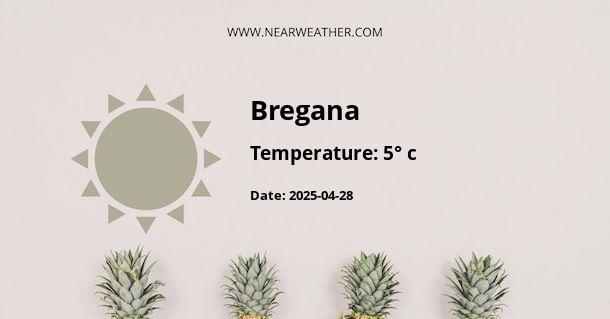Climate Overview of Bregana, Croatia
Bregana is a settlement located in the northern part of Croatia near the border with Slovenia. As a locale situated near the northwest of Zagreb, it experiences a climate typical of the continental region with nuances brought about by its geographic positioning and elevation. Understanding the climate of Bregana is vital for residents, businesses, and travelers alike.Seasonal Weather Patterns
The weather in Bregana is distinguished by four distinct seasons – spring, summer, autumn, and winter. Each period is characterized by different weather patterns, which I will elucidate upon utilizing expert climatological data.
Spring
- Temperature: Spring witnesses a gradual rise in temperature, kicking off with cooler March days, with the average temperature ranging from 3°C to 10°C and reaching warmer days in May with averages from 11°C to 21°C.
- Precipitation: Rainfall increases as spring progresses, with April and May often experiencing significant precipitation.
- Climate Events: Late frosts can occur during early spring, whereas late spring may bring thunderstorms.
Summer
- Temperature: The summer months June, July, and August showcase Bregana’s warmest temperatures, averaging from 14°C to 27°C, occasionally reaching higher peaks during heatwaves.
- Precipitation: Despite being relatively warm, summer can have its fair share of rainfall, though typically less frequent than in spring.
- Climate Events: Summer storms, occasionally with hail, can be a climatic feature of this season.
Autumn
- Temperature: Autumn observes a decrease in temperature, with averages tapering off from 10°C to 19°C in September to 1°C to 7°C in November.
- Precipitation: Rainfall tends to pick up in autumn, with October notably being one of the wettest months of the year.
- Climate Events: Mist and fog are common as the colder months close in, particularly in the mornings and evenings.
Winter
- Temperature: In winter, the average temperatures range from -3°C to 3°C, with January usually being the coldest month.
- Precipitation: Snowfall can be expected in winter, although it varies from year to year. Cold snaps with temperatures well below freezing can also occur.
- Climate Events: Ice and frost are regular occurrences, and caution is advised during these conditions, especially for transportation.
Annual Weather Statistics
To give an intricate perspective on Bregana's climate, it's essential to delve into the yearly weather statistics. The data in these tables and lists are compiled from historical weather reports and model-based estimations from meteorological experts.
| Month | Avg. High (°C) | Avg. Low (°C) | Avg. Precipitation (mm) |
|---|---|---|---|
| January | 3 | -3 | 40 |
| February | 5 | -2 | 35 |
| March | 10 | 1 | 50 |
| April | 16 | 5 | 55 |
| May | 21 | 10 | 70 |
| June | 24 | 13 | 75 |
| July | 27 | 14 | 70 |
| August | 27 | 14 | 65 |
| September | 21 | 11 | 70 |
| October | 16 | 6 | 80 |
| November | 9 | 2 | 80 |
| December | 4 | -2 | 55 |
Climatic Influences and Extremes
"Bregana's climate is markedly influenced by its inland location and proximity to the Dinaric Alps. These geographical features contribute to the range in temperature and precipitation seen throughout the year."
Given its location in the continental part of Croatia, Bregana's climate is also susceptible to extremes. Heatwaves during the summer can lead to unusual spikes in temperature, influencing both human activity and the natural ecosystem. Conversely, the settlement can experience cold waves in the winter that bring about a series of frosty days with substantially below-freezing temperatures.
Climate Change Impact
Climate change poses a palpable threat to the stability of weather patterns in regions like Bregana. Changes in average temperatures, precipitation patterns, and the frequency of extreme weather events are all concerns that are at the forefront of climatological research and environmental policy. Noteworthy trends indicate:
- An increase in the intensity and frequency of heatwaves.
- Shifts in precipitation patterns leading to dryer summers or more extreme rainfall events.
- The potential for less snowfall but more severe winter storms as global temperatures rise.
Studying these trends allows local communities, agricultural sectors, and businesses to adapt and mitigate the impact of an evolving climate.
Local Weather Services and Resources
Citizens and visitors in Bregana should make use of the various local weather services and resources to stay informed about current conditions and forecasts. Croatia’s National Meteorological and Hydrological Service (DHMZ) provides detailed, up-to-date weather reports, warnings, and long-term forecasts that are essential for planning and preparedness in response to the region's changing climate conditions.
Final Remarks on Bregana's Climate
Conclusively, Bregana experiences a continental climate with distinct seasons and varied weather patterns. Year-round, residents and visitors can expect a mix of warm summers, cool and wet autumns, cold winters, and mild springs. While enjoying the natural beauty of the region, individuals must remain vigilant and responsive to the challenges brought by climate change and extreme weather events.
Understanding the climate is key to exploring, enjoying, and living in Bregana. As such, staying well-informed through reliable meteorological data and forecasts will enhance one's preparedness for any climatic contingency that this charming Croatian locale might present.
A - Bregana's Latitude is 45.845558 & Longitude is 15.685280.
A - Weather in Bregana is 5° today.
A - Climate Conditions in Bregana shows mist today.
A - Humidity in Bregana is 100% today.
A - Wind speed in Bregana is 1.84 km/h, flowing at 270° wind direction. today.
